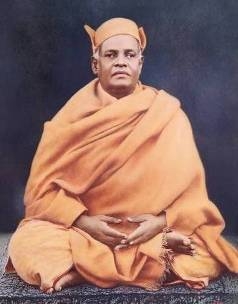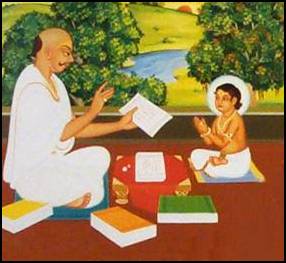|
Swaminarayan Mantra
The Swaminarayan mantra, "Swaminarayan," is a mantra used by the Swaminarayan Sampradaya. It is a compound of two words: ''Swami'' ("master, lord") and ''Narayana, Narayan'', that is, Vishnu c.q. Purushottam. According to the Swaminarayan-tradition, the Swaminarayan Mantra was introduced and explained by Swaminarayan, also known as Sahajanand Swami, spiritual head of the Swaminarayan Sampradaya, shortly after the death of his predecessor, Ramanand Swami. Devotees chant the Swaminarayan mantra to offer worship, to allay distress, to pray for the welfare of others, and at the end-of-life. Several scriptures of the Swaminarayan Sampradaya, such as the Swamini Vato, Harililamrut, and Bhaktachintamani, describe the power and efficacy of the Swaminarayan mantra for one who chants it. Origins Swaminarayan was given the mantra, ‘''Brahmāhaṃ Kṛṣṇadāso'smi'',’ which means “I am Brahman, servant of God.” In 1801, when Sahajanand Swami succeeded Ramanand Swami as the spir ... [...More Info...] [...Related Items...] OR: [Wikipedia] [Google] [Baidu] |
Swaminarayan Sampradaya
The Swaminarayan Sampradaya, also known as Swaminarayan Hinduism and Swaminarayan movement, is a Hindu Vaishnava sampradaya rooted in Ramanuja's Vishishtadvaita, characterized by the worship of its charismatic founder Sahajanand Swami, better known as Swaminarayan (1781–1830), whom many regard as an avatar of Krishna or as the highest Theophany, manifestation of Purushottama, Purushottam, the supreme God. According to the tradition's lore, both the religious group and Sahajanand Swami became known as ''Swaminarayan'' after the Swaminarayan mantra, which is a compound of two Sanskrit words, swami ("master, lord") and Narayana, Narayan (supreme God, Vishnu). During his lifetime, Swaminarayan Institutionalisation, institutionalized his charisma and beliefs in various ways. He constructed six mandirs to facilitate followers' devotional worship of God, and encouraged the creation of a scriptural tradition''.'' In 1826, in a legal document titled the Desh Vibhag Lekh, Lekh, Sw ... [...More Info...] [...Related Items...] OR: [Wikipedia] [Google] [Baidu] |
Swami
Swami (; ; sometimes abbreviated sw.) in Hinduism is an honorific title given to an Asceticism#Hinduism, ascetic who has chosen the Sannyasa, path of renunciation (''sanyāsa''), or has been initiated into a religious monastic order of Vaishnavas. It is used either before or after the subject's name (usually an adopted religious name). An alternative form, swamini (), is sometimes used by female renunciates. The meaning of the Sanskrit root of the word ''swami'' is "[he who is] one with his Philosophy of self#Self in Eastern traditions, self" ( stands for "self"), and can roughly be translated as "he/she who knows and is master of himself/herself". The term is often attributed to someone who has achieved mastery of a particular Yoga, yogic system or demonstrated profound devotion (''bhakti'') to one or more Hindu gods. The ''Oxford English Dictionary'' gives the etymology as: As a direct form of address, or as a stand-in for a swami's name, it is often rendered ''Swamiji'' (als ... [...More Info...] [...Related Items...] OR: [Wikipedia] [Google] [Baidu] |
Narayana
Narayana (, ) is one of the forms and epithets of Vishnu. In this form, the deity is depicted in yogic slumber under the celestial waters, symbolising the masculine principle and associated with his role of creation. He is also known as Purushottama, and is considered the Supreme Being in Vaishnavism. Etymology Narayan Aiyangar states the meaning of the Sanskrit word 'Narayana' can be traced back to the Laws of Manu (also known as the ''Manusmriti'', a ''Dharmaśāstra'' text), which states: This definition is used throughout post-Vedic literature such as the ''Mahabharata'' and the ''Vishnu Purana''. 'Narayana' is also defined as the 'son of the primeval man', and 'Supreme Being who is the foundation of all men'. *'Nara' (Sanskrit नार) means 'water' and 'man' *'Yana' (Sanskrit यान) means 'vehicle', 'vessel', or more loosely, 'abode' or 'home' L. B. Keny proposes that Narayana was associated with the Dravidian, and ultimately, the Indus Valley Civilis ... [...More Info...] [...Related Items...] OR: [Wikipedia] [Google] [Baidu] |
Vishnu
Vishnu (; , , ), also known as Narayana and Hari, is one of the Hindu deities, principal deities of Hinduism. He is the supreme being within Vaishnavism, one of the major traditions within contemporary Hinduism, and the god of preservation (sattva). Vishnu is known as ''The Preserver'' within the Trimurti, the triple deity of Para Brahman, supreme divinity that includes Brahma and Shiva.Gavin Flood, An Introduction to Hinduism' () (1996), p. 17. In Vaishnavism, Vishnu is the supreme Lord who creates, protects, and transforms the Hindu cosmology, universe. Tridevi is stated to be the energy and creative power (Shakti) of each, with Lakshmi being the equal complementary partner of Vishnu. He is one of the five equivalent deities in Panchayatana puja of the Smarta tradition of Hinduism. According to Vaishnavism, the supreme being is with qualities (Saguna Brahman, Saguna), and has definite form, but is limitless, transcendent and unchanging absolute Brahman, and the primal Atma ... [...More Info...] [...Related Items...] OR: [Wikipedia] [Google] [Baidu] |
Purushottam
Purushottamacharya (; 9th century) also known as Purushottama, was a vedantic philosopher and theologian. He was a disciple of Viśvācārya and the third after Nimbarka. He was 7th acharya of Nimbarka Sampradaya. Purushottamacharya composed ''Vedāntaratnamañjūṣā'', a commentary on Nimbārkācharya's work Vedanta kamadhenu dashashloki Life Puruṣottama, believed to have originated from the same region as Nimbārka, which corresponds to Pratiṣṭhāna in present-day Paithan, Maharashtra. He was born on the sixth day of the bright fortnight of the lunar month Caitra (approximately February-March in the Gregorian calendar). He is also referred to as ''Vivaraṇakāra'', meaning ''The Expositor'', a title that signifies his role in elucidating and deeply analyzing complex theological principles and intricate aspects of philosophy with clarity and precision. He flourished after Śaṅkara, as he criticises many full-fledged Advaita doctrines. Works * ''Vedāntaratnamañjū ... [...More Info...] [...Related Items...] OR: [Wikipedia] [Google] [Baidu] |
Swaminarayan
Swaminarayan (IAST: '; 3 April 1781 – 1 June 1830), also known as Sahajanand Swami, was a yogi and Asceticism, ascetic believed by followers to be a manifestation of Krishna or the highest Theophany, manifestation of Purushottama, around whom the Swaminarayan Sampradaya developed. In 1800, he was initiated into the ''Uddhava'' ''sampradaya'' by his guru, Swami Ramanand, and was given the name Sahajanand Swami. Despite opposition, in 1802, Ramanand handed over the leadership of the Uddhava Sampradaya to him before his death. According to the Swaminarayan tradition, Sahajanand Swami became known as Swaminarayan, and the Uddhava Sampradaya became known as the Swaminarayan Sampradaya, after a gathering in which he taught the Swaminarayan Mantra to his followers. He emphasized "moral, personal, and social betterment," and ''ahimsa''. He is also remembered within the sect for undertaking reforms for women and the poor, and performing large-scale non-violent yajna, yajñas (fire s ... [...More Info...] [...Related Items...] OR: [Wikipedia] [Google] [Baidu] |
Gunatitanand Swami
Gunatitanand Swami (28 September 1784 – 11 October 1867), born Mulji Jani, was a paramhansa of the Hindu Swaminarayan Sampradaya who was ordained by Swaminarayan and is accepted as the first spiritual successor of Swaminarayan by the Bochasanwasi Akshar Purushottam Swaminarayan Sanstha (BAPS). Born into a religious family in the small farming community of Bhadra in Gujarat, India, he first received religious education under his father's guru, Ramanand Swami, before encountering Swaminarayan and becoming a swami under him at the age of 25. For the BAPS, he embodies an essential element of the doctrine of Akshar and Purushottam. They believe, based on interpretation, from the Vachanamrut that "Akshar is an eternally-existing spiritual reality having two forms, the impersonal and the personal". Furthermore, BAPS claims that Gunatitanand Swami was believed to be the first personal manifestation of Akshar in the Guru Parampara: an unbroken line of "perfect devotees" who provi ... [...More Info...] [...Related Items...] OR: [Wikipedia] [Google] [Baidu] |
Indology
Indology, also known as South Asian studies, is the academic study of the history and cultures, languages, and literature of the Indian subcontinent, and as such is a subset of Asian studies. The term ''Indology'' (in German, ''Indologie'') is often associated with German scholarship, and is used more commonly in departmental titles in German and continental European universities than in the anglophone academy. In the Netherlands, the term ''Indologie'' was used to designate the study of Indian history and culture in preparation for colonial service in the Dutch East Indies. Classical Indology majorly includes the linguistic studies of Sanskrit literature, Pāli and Tamil literature, as well as study of Dharmic religions (like Hinduism, Buddhism, Sikhism, etc.). Some of the regional specializations under South Asian studies include: * Bengali studies – study of culture and languages of Bengal * Dravidology – study of Dravidian languages of Southern India ** Tamil studi ... [...More Info...] [...Related Items...] OR: [Wikipedia] [Google] [Baidu] |
Jan Gonda
Jan Gonda (14 April 1905 – 28 July 1991) was a Dutch Indologist and the first Utrecht professor of Sanskrit. He was born in Gouda, in the Netherlands, and died in Utrecht. He studied with Willem Caland at Rijksuniversiteit, Utrecht (since 1990 ) and from 1932 held positions at Utrecht and Leiden. He held the positions of Chair of Sanskrit succeeding Caland from 1929, as well as of Indology from 1932. He published scholarly articles on Indian Sanskrit and Indonesian Javanese texts for sixty years. In 1952, he published his monumental work on ''Sanskrit in Indonesia''. His contributions to philology and Vedic literature has been oft-cited. Gonda is recognized as one of the twentieth century's leading scholars of Asian language, literature and religion, particularly on texts and topics related to Hinduism and Buddhism. He wrote with ease and elegance in Dutch, English and German, and had a breath-taking range of interests from the ancient literature of Indonesia and India to c ... [...More Info...] [...Related Items...] OR: [Wikipedia] [Google] [Baidu] |
Japamala
A japamala, , or simply Japay mala (; , meaning 'garland') is a loop of prayer beads commonly used in Indian religions such as Hinduism, Buddhism, Jainism and Sikhism. It is used for counting recitations ('' japa'') of mantras, prayers or other sacred phrases. It is also worn to ward off evil, to count repetitions within some other form of '' sadhana'' (spiritual practice) such as prostrations before a holy icon. They are also used as symbols of religious identification. The main body of a mala usually consists of 108 beads of roughly the same size and material as each other, although smaller versions, often factors of 108 such as 54 or 27, exist. A distinctive 109th "guru bead" or mother bead, which is not counted, is very common. Mala beads have traditionally been made of a variety of materials such as wood, stone, gems, seeds, bone and precious metals—with various religions often favouring certain materials—and strung with natural fibres such as cotton, silk, or animal ... [...More Info...] [...Related Items...] OR: [Wikipedia] [Google] [Baidu] |





